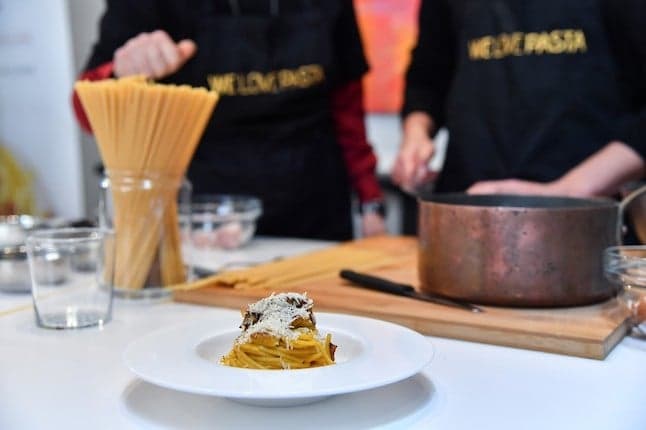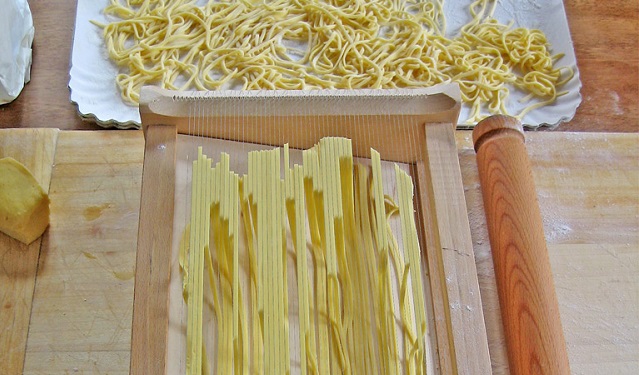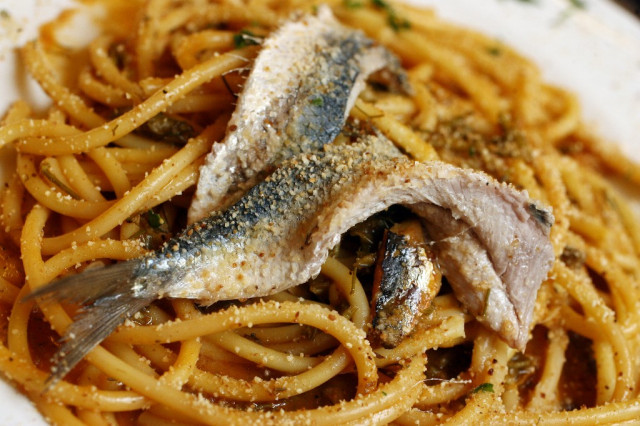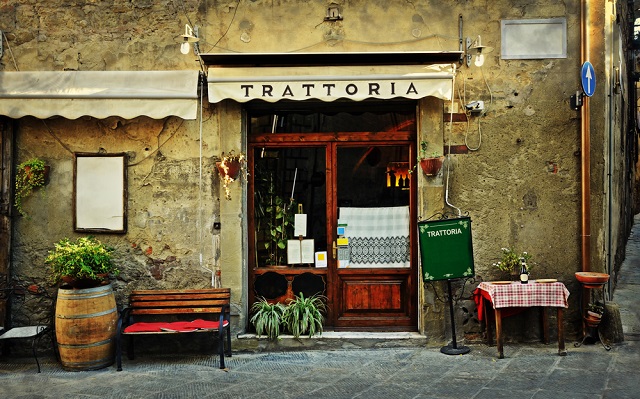The one pasta dish you have to try from each of Italy's regions

We don't know about you, but we can't imagine anything better than travelling Italy from top to toe, sampling the culinary delights of each of the places you stop at along the way.
But menu panic is a common pitfall for the uninitiated. If you're searching for authentic Italian food, you'll often find there's no translated version of the menu (sometimes there won't be a menu at all, but just a nonna or nonno reeling off the list of dishes on offer).
READ ALSO: How to decipher Italy's mind-boggling pasta menus
Many dishes known overseas, such as fettuccine alfredo or spaghetti bolognese, don't actually exist in Italy, except when restaurants are catering for tourists. And the cuisine varies a lot from place to place, so if you simply order the only thing on the menu you've heard of before, you might end up underwhelmed.
To eat like the locals do, try a regional specialty, which will be prepared with extra love and high quality fresh ingredients. Here are our top picks, with one from each of Italy's 20 regions. Foodie roadtrip, anyone?
Abruzzo: Maccheroni alla chitarra
This long, thin pasta shape is made using a special tool invented in 1890 and called a chitarra, which ensures the maccheroni have a porous texture so that sauce adheres well. You'll find it served with thick sauces based on tomatoes and meat, typically lamb ragu, with meatballs added in some parts of the region. Note: outside Abruzzo, the same dish is called spaghetti alla chitarra to avoid confusion with the short tube-shaped pasta also named maccheroni.

The maccheroni and the chitarra. Photo: fugsu/Flickr, CC BY 2.0
Aosta Valley: Pasta alla valdostana
Though pasta doesn't dominate the menus in Italy's smallest region as much as it does further south, when they do cook it, they do it well. This creamy recipe uses Fontina, a cheese known for melting extremely well and often used in fondue (Italian fondue is even more decadent than the Swiss variety, with butter and cream added). Eaten with or without added ham, it's the perfect comfort food after a day on the slopes. Or whenever, in our opinion.
Basilicata: Fusili con la mollica
In contrast to the Aosta Valley, pasta has a long, long history here. In fact, the region can boast that it's the first place in Italy with records of the foodstuff. Because it's historically been a poor area, Basilicata's dishes are typically simple, and they often contain the region's hot peppers. In this recipe 'mollica' refers to the soft inside part of bread, which is cooked up with tomatoes, onions, and red wine to make a tasty sauce.
Calabria: Pasta con le sarde
Eaten most often in Calabria and Sicily, many types of pasta can be used for this dish but you'll usually see long, thin tube shapes. The sauce combines sardines, anchovies and herbs including fennel and saffron.

Photo: Marcello Paternostro/AFP
Campania: Spaghetti alle vongole
Sticking with a seafood theme, classic spaghetti with clams is popular throughout the country, but we recommend sampling it when you're by the sea. The sauce is simple, featuring wine, garlic and chilli, making it a perfect light lunch or 'primo' course.
Emilia-Romagna: Cappellacci di zucca
Stuffed pasta is the name of the game in Italy's culinary capital, with local specialties including lasagne verdi (a variant of the classic dish using spinach sheets), meat-filled tortellini in broth, and cannelloni, the cousin of lasagne. But if forced to pick one stand-out dish from the area, we'd recommend cappellaci di zucca, small pasta parcels (the name literally means 'little hats') stuffed with pumpkin or squash and served with a simple butter and sage sauce or local ragu. Head to charming Ferrara where this autumnal dish has its origins.
READ ALSO: Ten surprising pasta facts in honour of Italy's favourite food
Friuli-Venezia-Giulia: Gnocchi di susine
The menus in this region are typically light on pasta and heavy on dumplings, so gnocchi are a good compromise between the two. This sweet version of gnocchi is a treat found in Trieste and the rest of the FVG region as well as in other countries that were once part of the Austro-Hungarian empire.
Elsewhere they're usually a dessert whereas Italians sometimes list them as an entree, but whenever you choose to enjoy them it's sure to be a unique pasta experience.
Lazio: Cacio e pepe
Literally meaning 'cheese and pepper' in the local dialect, this dish of just a few ingredients packs a flavoursome punch. Pecorino cheese and pepper are combined with the cooking water to make a sauce that coats the long, thin pasta, and it's a must-try when in Rome.
Liguria: Trenette al pesto
Another simple dish, but this pesto pasta is a world away from the dish made using a supermarket jar of the green stuff. Trenette is similar to linguine, a flat pasta that perfectly holds the basil-based sauce created in Liguria. Make sure you're getting true pesto genovese, which must be made using specific high quality ingredients and using a marble mortar and wooden pestle.
READ ALSO: Ten golden rules for making pasta like the Italians, from an artisan pasta maker
Lombardy: Pizzocheri alla valtellinese
This recipe originated in the town of Valtinella, and combines pizzocheri (think short buckwheat tagliatelle) with cabbage and potatoes. It's a winter dish, perfect for curling up with on chilly nights, with a generous dose of cheese and butter bringing it all together.
Marche: Vincisgrassi
Vincisgrassi is part of the lasagne family, but the ragu contains a bit of everything: mushrooms, pork and beef are the stars but it can also be a way of using up other odds and ends of meat such as chicken giblets and cock's comb. Records of the recipe date back centuries, with legend stating that a chef added a mix of extra ingredients to a classic ragu in order to impress a visiting general. The bechamel sauce is often infused with truffle oil to add that final fancy touch.
Molise: Cavatelli alla molisana
There are many reasons to head to Molise, a region of Italy most foreigners have never heard of, and one of them is the food. The name cavatelli means 'little cavities', and the shapes are similar to a shell, rolled up to form the cavity that traps the accompanying sauce. One of the sauces traditionally eaten with them is tomato-based, with sausage, carrots, and onions.
Piedmont: Agnolotti al plin
Agnolotti are a type of ravioli, and the Piemontese variant -- believed to be one of the very first stuffed pastas, created to celebrate the end of an historical siege -- is one of the best. The name 'al plin' comes from a local dialect term meaning 'to pinch', in reference to how the small pasta pockets are created. They're always filled with meat: rabbit, beef, pork, and in the Monferrato region donkey, and served in a simple broth or sage and butter sauce.
Puglia: Sagne Ncannulate
Puglia is a great region for a foodie holiday, and the local pasta specialty of sagne ncannulate are a must-eat. These long spirals are typically served with a thick tomato sauce including plenty of garlic and basil, and are a common Sunday dinner dish.
Sardinia: Fregola ai frutti di mare
The name of these teeny-tiny pasta balls (very similar to cous cous) translates as 'breadcumbs', and they're usually eaten with seafood caught from around the coast of the island. It can be incorporated into all kinds of meals including broths and risottos, but for a classic take on the recipe, look for a simple version served with scallops.
Sicily: Pasta alla norma
Pasta doesn't get classier than this, named after a Puccini opera. Aubergines are the star of the show here, mixed with tomatoes, ricotta, and basil.
Trentino-South Tyrol: Schlutzkrapfen
As with the other northern regions, pasta isn't such a staple here, but we can recommend this local dish, also known locally as Schlutzer. They're a kind of ravioli in a semi-circle shape, packed with ricotta and spinach in the classic version, but also served with plenty of other kinds of fillings.
Tuscany: Tortelli di patate
If you like carbs with your carbs, potato-filled pasta should be right up your street. Tortelli di patate are from the Mugello area, and you can eat them in a simple sauce like butter and sage, or with a hearty ragu. Like in neighbouring Emilia-Romagna, many typical Tuscan pasta dishes are stuffed, so you can also tuck into tortelli with chestnuts, ricotta and spinach, or meat fillings.
Umbria: Strangozzi al tartufo nero
Umbria is black truffle country, and a simple pasta dish with truffles, olive oil, and garlic is one of the best ways to experience the specialty. Stringozzi are long pasta shapes, named after shoelaces because of how they look, and are one of the region's typical pasta varieties.
Veneto: Bigoli con l'anatra
Bigoli is like bucatini or a thicker, hollow spaghetti, and is a favourite pasta in Venice and the surrounding area. It's usually served with duck, as the meat is more readily available than in other regions. It's not one for the squeamish though, as the recipe typically includes the duck skin, fat, and sometimes giblets and liver too.
NOW READ: The words and phrases you need to know to decipher Italian restaurant menus
Comments (2)
See Also
But menu panic is a common pitfall for the uninitiated. If you're searching for authentic Italian food, you'll often find there's no translated version of the menu (sometimes there won't be a menu at all, but just a nonna or nonno reeling off the list of dishes on offer).
READ ALSO: How to decipher Italy's mind-boggling pasta menus
Many dishes known overseas, such as fettuccine alfredo or spaghetti bolognese, don't actually exist in Italy, except when restaurants are catering for tourists. And the cuisine varies a lot from place to place, so if you simply order the only thing on the menu you've heard of before, you might end up underwhelmed.
To eat like the locals do, try a regional specialty, which will be prepared with extra love and high quality fresh ingredients. Here are our top picks, with one from each of Italy's 20 regions. Foodie roadtrip, anyone?
Abruzzo: Maccheroni alla chitarra
This long, thin pasta shape is made using a special tool invented in 1890 and called a chitarra, which ensures the maccheroni have a porous texture so that sauce adheres well. You'll find it served with thick sauces based on tomatoes and meat, typically lamb ragu, with meatballs added in some parts of the region. Note: outside Abruzzo, the same dish is called spaghetti alla chitarra to avoid confusion with the short tube-shaped pasta also named maccheroni.

The maccheroni and the chitarra. Photo: fugsu/Flickr, CC BY 2.0
Aosta Valley: Pasta alla valdostana
Though pasta doesn't dominate the menus in Italy's smallest region as much as it does further south, when they do cook it, they do it well. This creamy recipe uses Fontina, a cheese known for melting extremely well and often used in fondue (Italian fondue is even more decadent than the Swiss variety, with butter and cream added). Eaten with or without added ham, it's the perfect comfort food after a day on the slopes. Or whenever, in our opinion.
Basilicata: Fusili con la mollica
In contrast to the Aosta Valley, pasta has a long, long history here. In fact, the region can boast that it's the first place in Italy with records of the foodstuff. Because it's historically been a poor area, Basilicata's dishes are typically simple, and they often contain the region's hot peppers. In this recipe 'mollica' refers to the soft inside part of bread, which is cooked up with tomatoes, onions, and red wine to make a tasty sauce.
Calabria: Pasta con le sarde
Eaten most often in Calabria and Sicily, many types of pasta can be used for this dish but you'll usually see long, thin tube shapes. The sauce combines sardines, anchovies and herbs including fennel and saffron.

Photo: Marcello Paternostro/AFP
Campania: Spaghetti alle vongole
Sticking with a seafood theme, classic spaghetti with clams is popular throughout the country, but we recommend sampling it when you're by the sea. The sauce is simple, featuring wine, garlic and chilli, making it a perfect light lunch or 'primo' course.
Emilia-Romagna: Cappellacci di zucca
Stuffed pasta is the name of the game in Italy's culinary capital, with local specialties including lasagne verdi (a variant of the classic dish using spinach sheets), meat-filled tortellini in broth, and cannelloni, the cousin of lasagne. But if forced to pick one stand-out dish from the area, we'd recommend cappellaci di zucca, small pasta parcels (the name literally means 'little hats') stuffed with pumpkin or squash and served with a simple butter and sage sauce or local ragu. Head to charming Ferrara where this autumnal dish has its origins.
READ ALSO: Ten surprising pasta facts in honour of Italy's favourite food
Friuli-Venezia-Giulia: Gnocchi di susine
The menus in this region are typically light on pasta and heavy on dumplings, so gnocchi are a good compromise between the two. This sweet version of gnocchi is a treat found in Trieste and the rest of the FVG region as well as in other countries that were once part of the Austro-Hungarian empire.
Elsewhere they're usually a dessert whereas Italians sometimes list them as an entree, but whenever you choose to enjoy them it's sure to be a unique pasta experience.
Lazio: Cacio e pepe
Literally meaning 'cheese and pepper' in the local dialect, this dish of just a few ingredients packs a flavoursome punch. Pecorino cheese and pepper are combined with the cooking water to make a sauce that coats the long, thin pasta, and it's a must-try when in Rome.
Liguria: Trenette al pesto
Another simple dish, but this pesto pasta is a world away from the dish made using a supermarket jar of the green stuff. Trenette is similar to linguine, a flat pasta that perfectly holds the basil-based sauce created in Liguria. Make sure you're getting true pesto genovese, which must be made using specific high quality ingredients and using a marble mortar and wooden pestle.
READ ALSO: Ten golden rules for making pasta like the Italians, from an artisan pasta maker
Lombardy: Pizzocheri alla valtellinese
This recipe originated in the town of Valtinella, and combines pizzocheri (think short buckwheat tagliatelle) with cabbage and potatoes. It's a winter dish, perfect for curling up with on chilly nights, with a generous dose of cheese and butter bringing it all together.
Marche: Vincisgrassi
Vincisgrassi is part of the lasagne family, but the ragu contains a bit of everything: mushrooms, pork and beef are the stars but it can also be a way of using up other odds and ends of meat such as chicken giblets and cock's comb. Records of the recipe date back centuries, with legend stating that a chef added a mix of extra ingredients to a classic ragu in order to impress a visiting general. The bechamel sauce is often infused with truffle oil to add that final fancy touch.
Molise: Cavatelli alla molisana
There are many reasons to head to Molise, a region of Italy most foreigners have never heard of, and one of them is the food. The name cavatelli means 'little cavities', and the shapes are similar to a shell, rolled up to form the cavity that traps the accompanying sauce. One of the sauces traditionally eaten with them is tomato-based, with sausage, carrots, and onions.
Piedmont: Agnolotti al plin
Agnolotti are a type of ravioli, and the Piemontese variant -- believed to be one of the very first stuffed pastas, created to celebrate the end of an historical siege -- is one of the best. The name 'al plin' comes from a local dialect term meaning 'to pinch', in reference to how the small pasta pockets are created. They're always filled with meat: rabbit, beef, pork, and in the Monferrato region donkey, and served in a simple broth or sage and butter sauce.
Puglia: Sagne Ncannulate
Puglia is a great region for a foodie holiday, and the local pasta specialty of sagne ncannulate are a must-eat. These long spirals are typically served with a thick tomato sauce including plenty of garlic and basil, and are a common Sunday dinner dish.
Sardinia: Fregola ai frutti di mare
The name of these teeny-tiny pasta balls (very similar to cous cous) translates as 'breadcumbs', and they're usually eaten with seafood caught from around the coast of the island. It can be incorporated into all kinds of meals including broths and risottos, but for a classic take on the recipe, look for a simple version served with scallops.
Sicily: Pasta alla norma
Pasta doesn't get classier than this, named after a Puccini opera. Aubergines are the star of the show here, mixed with tomatoes, ricotta, and basil.
Trentino-South Tyrol: Schlutzkrapfen
As with the other northern regions, pasta isn't such a staple here, but we can recommend this local dish, also known locally as Schlutzer. They're a kind of ravioli in a semi-circle shape, packed with ricotta and spinach in the classic version, but also served with plenty of other kinds of fillings.
Tuscany: Tortelli di patate
If you like carbs with your carbs, potato-filled pasta should be right up your street. Tortelli di patate are from the Mugello area, and you can eat them in a simple sauce like butter and sage, or with a hearty ragu. Like in neighbouring Emilia-Romagna, many typical Tuscan pasta dishes are stuffed, so you can also tuck into tortelli with chestnuts, ricotta and spinach, or meat fillings.
Umbria: Strangozzi al tartufo nero
Umbria is black truffle country, and a simple pasta dish with truffles, olive oil, and garlic is one of the best ways to experience the specialty. Stringozzi are long pasta shapes, named after shoelaces because of how they look, and are one of the region's typical pasta varieties.
Veneto: Bigoli con l'anatra
Bigoli is like bucatini or a thicker, hollow spaghetti, and is a favourite pasta in Venice and the surrounding area. It's usually served with duck, as the meat is more readily available than in other regions. It's not one for the squeamish though, as the recipe typically includes the duck skin, fat, and sometimes giblets and liver too.
NOW READ: The words and phrases you need to know to decipher Italian restaurant menus

Join the conversation in our comments section below. Share your own views and experience and if you have a question or suggestion for our journalists then email us at [email protected].
Please keep comments civil, constructive and on topic – and make sure to read our terms of use before getting involved.
Please log in here to leave a comment.